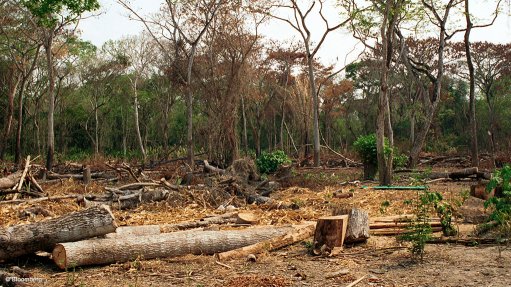
DWINDLING FORESTS
The Centre for Amazonian Scientific Innovation's research notes that Peruvian deforestation is 30% more than previously reported
Photo by: Bloomberg
Small-scale gold mining has destroyed more than 68 000 ha of primary rainforest in the Peruvian Amazon in the past five years, according to a new analysis by scientists at US-based private tertiary institution Wake Forest University’s Centre for Amazonian Scientific Innovation (CINCIA).
The research, published two weeks ago on the university’s website, notes that the deforestation has affected an area that is 30% bigger than previously reported.
“The scale of the deforestation is really shocking,” says CINCIA executive director and research associate Professor Luis Fernandez.
The scientists at CINCIA have developed a new data fusion method to identify areas destroyed by this small- or artisanal-scale mining. The new deforestation detection tool is 20% to 25% more accurate than those used previously.
Mapping systems CLASlite and the Global Forest Map use different kinds of information from light waves to show changes in the landscape. “Combining the two methods gives us really good information about the specific kind of deforestation we’re looking for,” says CINCIA associate director of science and Wake Forest University Center for Energy, Environment, and Sustainability director Miles Silman.
Silman has researched biodiversity and ecology in the Western Amazon and Andes for more than 25 years.
“Artisanal-scale gold mining has been hard to detect because its after effects can masquerade as natural wetlands from a satellite view. But the damage is extensive,” notes Silman.
“We’re not talking about huge gold veins here,” Fernandez comments. “But there’s enough gold in the landscape to make a great deal of money in a struggling economy. You just have to destroy an immense amount of land to get it.”
He says the artisanal miners strip the land and use mercury to recover the gold. Unlike the formal gold industry, there are no restrictions on the types and quantities of toxic chemicals used.
He explains that artisanal-scale gold mining took root in the Peruvian Amazon in the early 2000s, coinciding with construction of a new modern highway connecting Peru and Brazil. The Interoceanic Highway made Peru’s rainforest accessible.
Fernandez notes that artisanal-scale gold mining has left a patchwork of mercury-polluted ponds and sand dunes.
CINCIA has partnered with Peru’s Ministry of the Environment to determine how the new tool developed by its scientists can be used to identify deforestation caused by artisanal-scale gold mining so that the institution can take effective action to curb the damage.
“We want to integrate high-quality scientific research into the processes the government is using for environmental conservation in Madre de Dios,” Fernandez says. “If they can institutionalise these technological innovations, they [will be able to] more reliably address threats to the rainforest. You have to respond quickly and you have to respond effectively.”
CINCIA scientists are also studying native species that can be used for post-mining reforestation. The 46 ha experiment at CINCIA’s headquarters is the largest in the Americas.